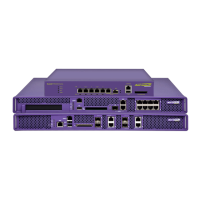Summit WM3000 Series Controller System Reference Guide 117
9 Refer to the Status field for the current state of the requests made from applet. This field displays
error messages if something goes wrong in the transaction between the applet and the controller.
10 Click on the Radius... button (when Radius is selected as the accounting mode) to configure an
external primary and secondary Radius and NAC server. For more information, see “Configuring
External Radius Server Support” on page 133.
11 Select the Syslog button (when Syslog is selected as the accounting mode) to view controller syslog
accounting details. To enable syslog, select the Syslog option from the Accounting Mode drop-down
menu. Use this sub screen to provide the Syslog Server IP address and port for the Syslog Server
performing the accounting function.
12 If clustering and the Cluster GUI feature is enabled the Apply to Cluster feature will be available.
Click the Apply to Cluster button to apply the WLAN settings to all members in the cluster.
13 Click OK to use the changes to the running configuration and close the dialog.
14 Click Cancel to close the dialog without committing updates to the running configuration.
MU to MU Traffic
Allows frames from one MU (where the destination MAC is of another
MU) are switched to a second MU. Use the drop-down menu to select
one of the following options:
•
Drop Packets
– This restricts MU to MU communication based on the
WLAN’s configuration
•
Allow Packets
– This allows MU to MU communication based on the
WLAN’s configuration
MU Idle Time
Set the MUs idle time limit in seconds. The default value is 1800
seconds.
Access Category
Displays the Access Category for the intended traffic. The Access
Categories are the different WLAN-WMM options available to the radio.
The Access Category types are:
•
Automatic/WMM
– Optimized for WMM
•
Voice
– Optimized for voice traffic. Voice packets receive priority.
•
Video
– Optimized for video traffic. Video packets receive priority.
•
Normal
– Optimized for normal traffic
•
Low
– Optimized for background traffic
MCast Addr 1
The address provided takes packets (where the first 4 bytes match the
first 4 bytes of the mask) and sends them immediately over the air
instead of waiting for the DTIM period. Any multicast/broadcast that does
not match this mask will go out only on DTIM Intervals.
MCast Addr 2
The second address also takes packets (where the first 4 bytes match the
first 4 bytes of the mask) and sends them immediately over the air
instead of waiting for the DTIM period. Any multicast/broadcast that does
not match this mask will go out only on DTIM Intervals.
NAC Mode
Using
Network Access Control
(NAC), the controller only grants access to
specific network resources. NAC restricts access to only compliant and
validated devices (printers, phones, PDAs etc.), thereby limiting the risk
of emerging security risks. NAC performs an authorization check for users
and MUs without a NAC agent, and verifies a MU’s compliance with the
network security policy. The controller supports only the EAP/802.1x type
of NAC. However, the controller can bypass NAC for MU’s without NAC
802.1x support. For the implications of using the include and exclude
with NAC, see “Configuring the NAC Inclusion List” on page 156,
“Configuring the NAC Exclusion List” on page 160 and “Configuring NAC
Server Support” on page 138
.

